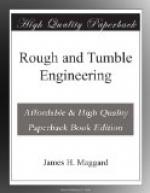The header is used by placing the gauge or guide end within the flue, and with your light hammer the flue can be calked or beaded down against the flue sheet. Be careful to use your hammer lightly, so as not to bruise the flues or sheet. When you have gone over all the expanded flues in this way, you, (if you have been careful) will not only have a good job, but will conclude that you are somewhat of an expert at it. I never saw a man go into a firebox and stop the leak but that he came out well pleased with himself. The fact that a firebox is no pleasant workshop may have had something to do with it. If your flues have been leaking badly, and you have expanded them, it would be well to test your boiler with cold water pressure to make sure that you have a good job.
How are you going to test your boiler? If you can attach to a hydrant, do so, and when you have given your boiler all the pressure you want, you can then examine your flues carefully, and should you find any seeping of water, you can use your beader lightly untill such leaks are stopped. If the waterworks will not afford you sufficient pressure, you can bring it up to the required pressure, by attaching a hydraulic pump or a good force pump.
In testing for the purpose of ascertaining if you have a good job on your flues, it is not necessary to put on any greater cold water pressure than you are in the habit of carrying. For instance, if your safety valve is set at one hundred and ten pounds, this pressure of cold water will be sufficient to test the flues.
Now, suppose you are out in the field and want to test your flues. Of course you have no hydrant to attach to, and you happen not to have a force pump, it would seem you were in bad shape to test your boiler with cold water. Well, you can do it by proceeding in this way: When you have expanded and beaded all the flues that were leaking, you will then close the throttle tight, take off the safety valve (as this is generally attached at the highest point) and fill the boiler full, as it is absolutely necessary that all the space in the boiler should be filled with cold water. Then screw the safety valve back in its place. You will then get back in the firebox with your tools and have someone place a small sheaf of wheat or oat straw under the firebox or under waist of boiler if open firebox, and set fire to it. The expansive force of the water caused by the heat from the burning straw will produce pressure desired. You should know, however, that your safety is in perfect order. When the water begins to escape at the safety valve, you can readily see if you have expanded your flues sufficiently to keep them from leaking.
This makes a very nice and steady pressure, and although the pressure is caused by heat, it is a cold water pressure, as the water is not heated beyond one or two degrees. This mode of testing, however, cannot be applied in very cold weather, as water has no expansive force five degrees above or five degrees below the freezing point.




